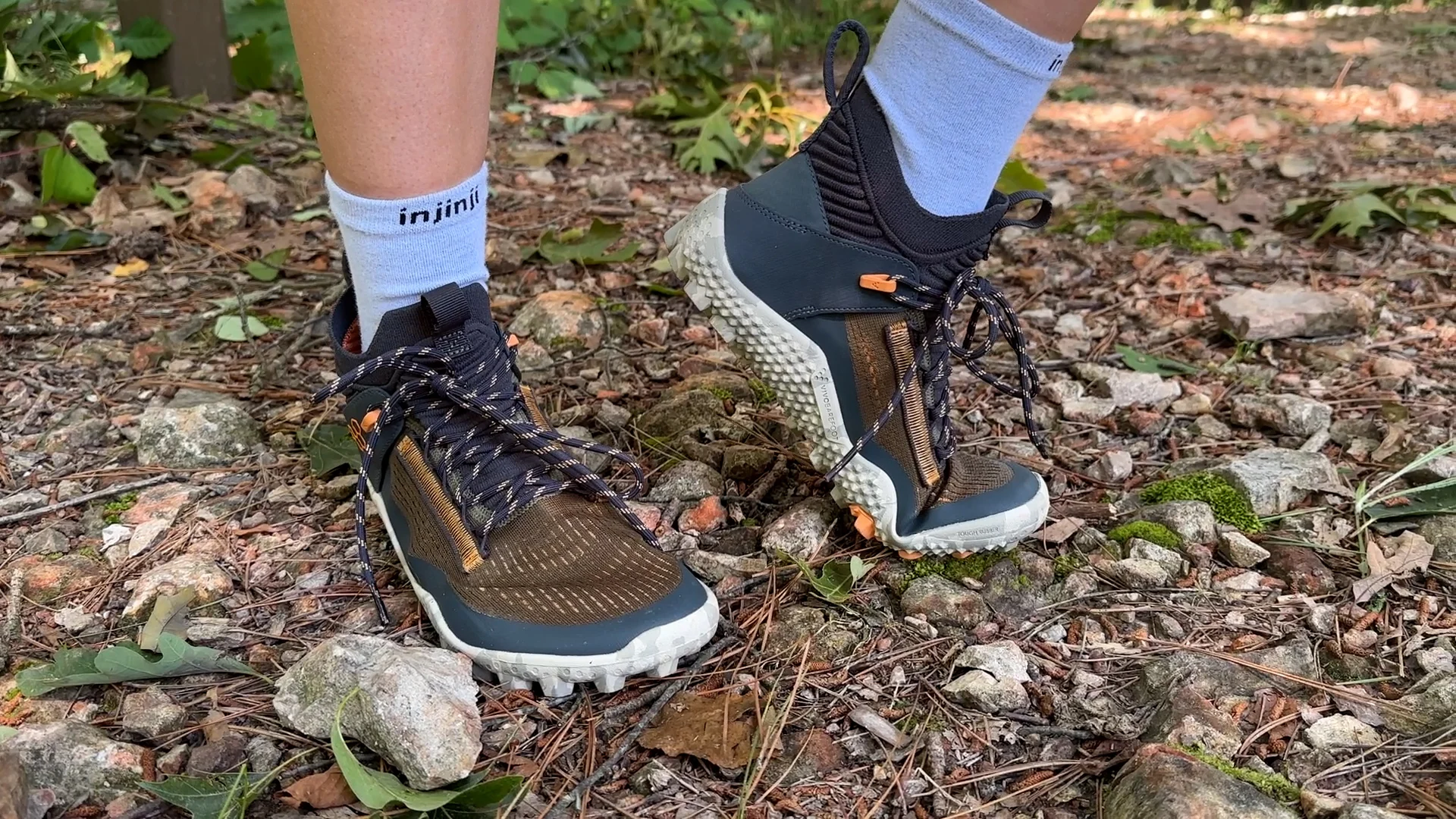Hiking shoes should fit snugly without pinching, allowing toes room to wiggle. Know How Hiking Shoes Should Fit, they must support the ankle and have a secure heel.
Selecting the perfect pair of hiking shoes can be the difference between a treacherous trek and a comfortable adventure. Crucial to every hiker’s gear, the right shoes provide the necessary support, protection, and traction for diverse terrains. A proper fit is essential, ensuring stability and minimizing the risk of blisters or injuries during prolonged activity.
Abundant toe space prevents cramping, while a snug fit around the midfoot and heel secures the foot and avoids unnecessary movement. Bear in mind, your feet may swell after hours of walking, so consider this when sizing. High-quality hiking footwear, tailored to your foot shape and trail requirements, can significantly enhance your outdoor experience.

Credit: www.trespass.com
The Importance of Understanding: How Hiking Shoes Should Fit
The Importance of Proper Fit in hiking shoes cannot be overemphasized. Your feet take you everywhere, especially on the trails where they encounter rocky paths, slippery streams, and steep inclines. With each step, your shoe’s fit will determine not only your comfort but also your stability and safety on these varying terrains. It’s crucial to find the right balance between snugness and room for movement.
Balancing Comfort And Support
Hiking shoes should feel like a second skin, offering both comfort and support. Here are the essentials:
- Your toes need wiggle room to prevent cramping.
- The heel must fit snugly to avoid slipping.
- Arch support is vital for long treks.
- A firm, cushioned insole can reduce foot fatigue.
Remember, well-fitting shoes stabilize your steps and help maintain your footing.
Avoiding Injuries And Blisters
A proper fit isn’t just about comfort; it’s a shield against common hiking ailments. Consider these tips:
- Ensure there’s enough space to prevent toes from hitting the shoe’s front on descents.
- Choose breathable materials to reduce moisture and heat.
- Select a padded collar to minimize ankle friction.
- Pick a secure lacing system to keep your foot in place.
Preventing blisters and injuries is essential to enjoy your hike and protect your feet.
Anatomy Of Best Hiking Boots
Understanding the Anatomy of Hiking Shoes is crucial for outdoor enthusiasts. The right fit not only boosts comfort but also enhances safety. Diving into the shoe’s anatomy reveals the complexity behind its design and the importance of each component in function and comfort. Let’s explore the key parts of hiking shoes to ensure an informed choice for your next outdoor adventure.
Identifying Key Components
Hiking shoes consist of various parts that work together. Each part plays a vital role. A brief rundown of these includes:
- Upper: Protects the foot and allows breathability.
- Insole: Offers cushioning and support.
- Midsole: Absorbs shock and adds stability.
- Outsole: Provides traction and durability.
- Toe cap: Shields toes from rocks and debris.
- Laces: Ensure a secure fit.
Materials And Flexibility
The materials used in hiking shoes greatly affect their performance. Shoes must balance flexibility with support. Materials include:
| Component | Material | Function |
|---|---|---|
| Upper | Leather or Synthetic | Durability and Protection |
| Midsole | EVA or PU | Cushioning and Support |
| Outsole | Rubber | Traction and Grip |
A perfect hiking shoe ensures enough flexibility to move naturally while walking. Yet it must also offer stiffness to avoid quick fatigue. Find a balance to tackle tough terrains safely.
Measuring Your Feet
Finding the perfect fit for hiking shoes starts with an accurate measurement of your feet. It’s crucial to avoid discomfort and blisters on the trail. Take the time to measure your feet correctly and consider various factors that affect shoe fit.
Tools And Techniques
Measuring your feet at home is straightforward with the right tools. Here’s what you’ll need:
- A pen or pencil
- A ruler or a measuring tape
Accounting For Socks And Swelling
When it comes to hiking shoes, accounting for socks and foot swelling is vital. Always measure your feet with the socks you’ll wear while hiking. If you plan on long hikes, consider the swelling that occurs.
Here are some tips:
- Choose moisture-wicking, well-cushioned hiking socks.
- Leave extra space to accommodate swelling and thicker socks.
- Size up if between sizes, especially for longer treks.
Perfectly fitting hiking shoes enhance performance and ensure comfort on the trail. Taking the time to measure your feet considering socks and possible swelling sets the stage for adventures with happy feet.
Trying On Hiking Shoes
Finding the right hiking shoes can make or break your trail experience. It’s essential to try on shoes before hitting the trails. A proper fit ensures comfort and prevents blisters and foot fatigue.
The Checklist For A Perfect Fit
- Measure your feet: Feet swell throughout the day, so measure them in the afternoon.
- Check the size: Leave a thumb’s width between your toes and the shoe end.
- Heel hold: Your heel should stay in place when you walk.
- Room to wiggle: Toes need space to move without rubbing the front.
- Try with socks: Wear the socks you’ll hike in for a true fit.
- Walk around: Test on various surfaces to simulate trails.
- Support: Insoles and arch support should feel comfortable.
Lacing Tricks For Enhanced Fit
Proper lacing can improve a shoe’s fit. Utilize these tricks to enhance comfort.
- Heel lock: Use lacing to secure the heel and prevent slipping.
- Window lacing: Relieves pressure on sensitive areas by skipping eyelets.
- Toe-relief lacing: Loosen near the toe box if toes feel cramped.
- Surgeon’s knot: Tighten lacing at specific points for a tailored fit.
Testing The Fit
Let’s talk about how your hiking shoes should hug your feet perfectly. We need to test if they fit right before hitting the trails. To do this, we’ll perform a few simple checks. Your adventures depend on comfy feet, so let’s make sure you have the best fit!
Indoor Trials
First, you’ll want to try your hiking shoes on indoors. This keeps them clean, in case you need to return them. Check these pointers while walking around:
- Heel Slip: Your heel should stay put. A little slip? Not good.
- Wiggle Room: Toes can dance a bit, but not too much.
- Snug Fit: Shoes should be snug, but not squeeze-like-a-snake tight.
- Comfort: Make sure nothing pinches or rubs you the wrong way.
Remember, wear your hiking socks during this test. They make a big difference.
Inclines And Declines
Next, simulate walking up and down hills. Use a ramp or stairs in your home for this.
| When Going Up | When Going Down |
|---|---|
| Your toes should not hit the front. | Heels must stay in place, no slip. |
| Laces keep your foot secure. | Check for pressure on your toes. |
These tests tell you if your hikes will be blister-free. They ensure you don’t slide around in your shoes.

Credit: www.rei.com
When To Replace Hiking Shoes
Knowing when to replace hiking shoes is crucial for trekkers. The right time ensures comfort and safety. Overlooking wear and tear can lead to discomfort or, worse, injury. Let’s explore the signs that indicate it’s time for a new pair.
Signs Of Wear And Tear
- Thinning soles: If soles feel less cushioned, they may be worn thin.
- Smooth treads: Treads should be deep for traction. Smooth ones mean it’s time for new shoes.
- Upper damage: Tears or separations in the upper part reduce support.
- Inner sole shape: A molded shape to your foot isn’t good. It means less support.
- Uneven wear: Check if one side of the sole wears down faster. It can affect your stride.
The Impact Of Shoe Aging On Fit
Aging footwear changes how it fits. Here’s what happens:
| Shoe Part | Aging Impact |
|---|---|
| Midsoles | Can harden or compress, lessening support. |
| Upper Material | May stretch out, causing a loose fit. |
| Laces | Can fray or stretch, making secure tying tough. |
| Waterproofing | Degrades over time, leading to wet feet. |
Remember, proper fit and condition keep hikes enjoyable. Inspect your shoes regularly and replace them when they show these signs.

Credit: terradrift.com
Frequently Asked Questions On How Should Hiking Shoes Fit
Should Hiking Shoes Be Tight Or Loose?
Allow room to wiggle your toes, and ensure heel security to prevent blisters. Choose a fit that avoids slippage yet doesn’t constrict circulation.
Should You Buy A Size Bigger In Hiking Shoes?
Yes, consider purchasing hiking shoes one size bigger to accommodate foot swelling and thicker socks during long treks.
Should Your Toes Touch The End Of Your Hiking Shoes?
Leave a thumb’s width of space to prevent blisters. Ensure comfort and support for downhill trails.
How Do I Know If My Hiking Boots Are Too Small?
Check for tightness around the toes and heels; discomfort indicates small boots. Ensure a thumb’s width at the toe end when standing. Notice any heel lift or blisters post-walk – these suggest a poor fit. Avoid boots that constrict movement or cause numbness.
Conclusion
Selecting the right hiking shoes can elevate your outdoor adventures. Ensure a snug, comfortable fit with ample toe room. Remember, the trails await, and your feet’s well-being is pivotal. Embrace the journey with confidence in every step. Happy hiking and safe trails ahead!

